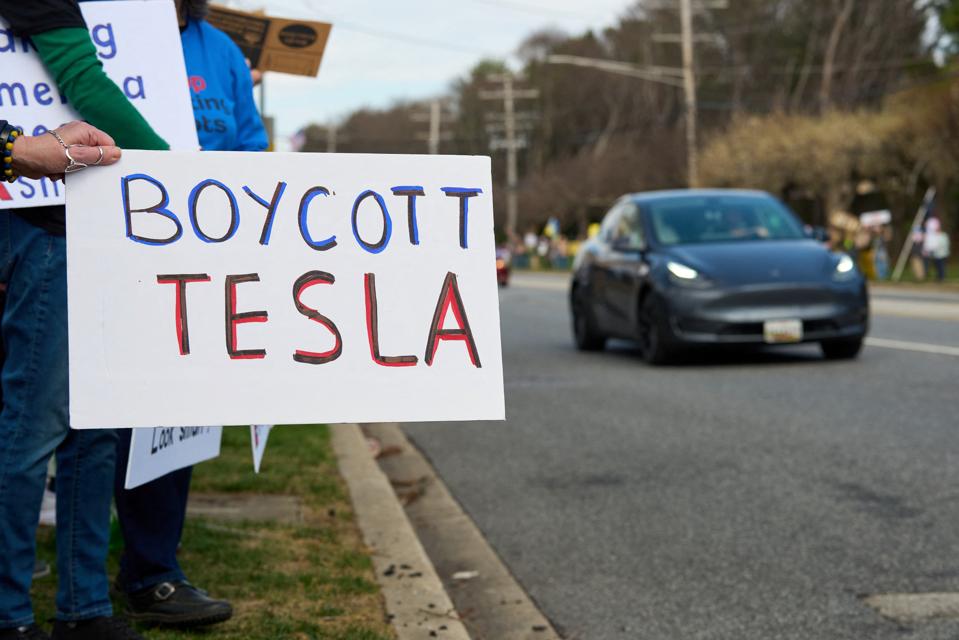Tesla has just released its Q1 2025 production and delivery numbers. The electric vehicle (EV) automaker confirmed delivery of 336,681 EVs during the first three months of the year—far below expectations, and approximately 50,000 less than their Q1 deliveries of 386,810 EVs.
While some of this was expected, it wasn’t helped by recent unrest over the brand and the CEO.
This past weekend, the streets of San Francisco and other cities across the nation (it’s estimated that it topped 200) were alive with chants and banners, as protesters gathered for the “Tesla Takedown,” a national day of action targeting Tesla CEO Elon Musk and his role in the Trump administration’s Department of Government Efficiency (DOGE).
What began as localized demonstrations outside Tesla showrooms has now evolved into a broader movement, uniting activists from diverse backgrounds in opposition to Musk’s policies and his influence on the administration’s sweeping cuts to government agencies, including the Veterans Administration (VA). These cuts have sparked outrage among veterans and their advocates, many of whom joined the protests to voice their concerns.
The Moment That Turned Into A Movement
The movement’s organizers have made it clear that their goal is to hit Musk where it hurts most—his pocketbook.
The Tesla Takedown movement is emblematic of a growing trend in activism: targeting corporations and their leaders as a means of influencing political decisions. By urging consumers to boycott Tesla, organizers hope to pressure Musk to reconsider his policies and their impact on vulnerable populations.
The protests also highlight how consumer behavior can be leveraged to drive change. While Tesla has yet to release a statement addressing the protests, the company’s decision to increase security at its dealerships and remove cars from showrooms suggests that it is taking the movement seriously.
The “Takedown” also seems to be affecting Tesla’s stock price. Company shares (NAS:TSLA) are approximately 45% off their record high of 488.54, reached on December 18, with more than $500 billion being wiped off the company’s value. The stock rebounded 3.6% on April 1 but is still stuck below the 200-day line.
Protesters Are Coming In Peace—But Not All Of Them
Despite the charged emotions fueling the Tesla Takedown, the peaceful nature of the protests underscores the movement’s focus on constructive action rather than confrontation. With this strategy, the movement has managed to amplify its message without alienating potential allies or escalating tensions. This approach reflects a broader trend in modern activism, where peaceful demonstrations are increasingly seen as a more effective means of achieving long-term goals.
Beyond the Takedown, other protests to date have not been so peaceful. Consumer and activist vandalism, such as spray-painting Tesla vehicles and using incendiary devices to set fire to showrooms and cars, has been happening since the inauguration on January 20, 2025. Those activists have vowed to continue their demonstrations, signaling that this movement has staying power.
For Musk and Tesla, the challenge will be navigating the pressures of these critics seeking to tarnish Tesla’s reputation. According to a new Yahoo News/YouGov poll, over two-thirds of Americans now say they wouldn’t consider buying or leasing a Tesla. That is a much different tune for the once beloved EV automaker.
A Cautionary Tale For Others?
For the corporate world, the Tesla Takedown serves as a cautionary tale about the risks of intertwining business leadership with political agendas. The protests highlight the growing expectation that corporate leaders must be accountable not only to shareholders but also to the broader public, whose lives are impacted by their decisions. It also highlights that actively engaging in government in a polarized society makes you a lightning rod for criticism—on both the business side and the political side—serving as a powerful reminder of the interconnectedness of business, politics, and social responsibility.
In an era of heightened activism and consumer awareness, the line between corporate actions and public accountability is increasingly becoming blurred. And for companies of all sizes and the leaders who are tasked to drive growth, the message is clear: values matter. The public isn’t just watching—they’re participating with their voices, their wallets and their influence.

